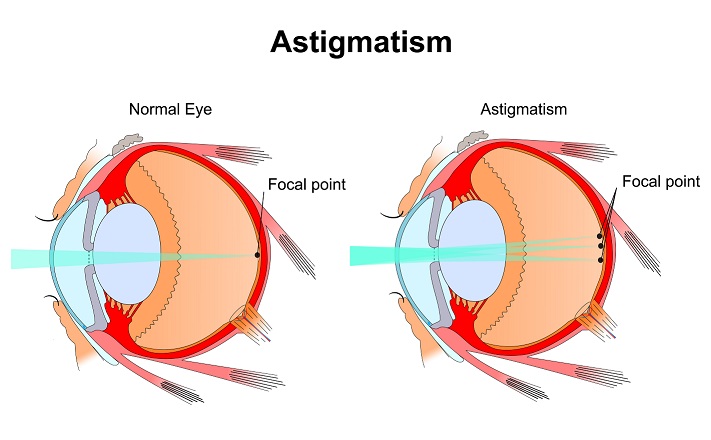Astigmatism

Astigmatism is a common eye condition marked by blurred vision across all distances that typically presents early in life. Like myopia and hyperopia, it is a refractive error that prevents light entering the eye from being focused correctly on the retina.
Myopia (or nearsightedness) is a refractive error in which images are focused in front of the retina instead of directly on its surface, resulting in poor distance vision. Hyperopia (or farsightedness) is essentially the opposite of myopia, in which images are focused behind the retina, resulting in poor near vision. Myopia occurs when the depth of the eyeball, moving from the front of the cornea to the back of the eye, is too long, and hyperopia occurs when the depth of the eyeball is too short. Astigmatism affects vision across all distances, so what abnormality of the eye is to blame?
For a quick introduction to astigmatism, check out the following short video, or continue reading below for in depth information about the causes, symptoms, types and treatment of astigmatism.
What Causes Astigmatism?
Astigmatism primarily relates to the shape of the cornea. optimally functioning eyeball should have a rounded cornea shaped like a ping pong ball. This allows for perfect refraction.
Astigmatism occurs when the shape of the cornea is stretched in more of an oval or football shape. This abnormality prevents light entering the eye from coming to a single focus point on the retina. Instead, the football-like shape of the cornea results in multiple points of focus in front of the retina and behind it. Which in turn causes blurred vision at varying distances.
Astigmatism normally results from natural causes, but it may also result from an injury, or in rare cases as an unintended consequence of eye surgery (called corneal ectasia). Keratoconus (KC) — a progressive eye disorder that causes thinning of the cornea — is a rare condition that can also lead to astigmatism.
Symptoms of Astigmatism
In addition causing blurred vision, additional symptoms of astigmatism can include:
- Eye strain / fatigue
- Squinting
- Headaches
- Multiple Images, such as one oncoming headlight appears like two
If you’re experiencing any of these symptoms, schedule an exam with an eye doctor to undergo a comprehensive evaluation of your vision.
Types of Astigmatism
There are various types of astigmatism, the definitions of which can be a little confusing. You can get into the weeds with your eye doctor during your consultation about the specifics, but for now we will describe three distinct types: regular, irregular and lenticular.
Before we get into an explanation of each type, we must first get a little technical and describe the various angels of defocus that occur due to astigmatism. To define these angles we use meridians.
A meridian is any line drawn along the apex of the cornea, dividing it into two parts. To picture this, think of a sphere with multiple lines drawn around the diameter, all from different directions. The lines all have the same curvature, even though they are drawn at various angles. However, if you stretch the sphere into an oval, football shape, you’ll notice that the lines you drew no longer share the same curvature. A line drawn from the front to the back of this oval shape has a flatter curvature, while a line drawn from the top to the bottom of the shape has a steeper curvature. The flattest and steepest parts of this line are referred to as the principal meridians.

Now that we’ve gotten that rather technical explanation out of the way, let’s look at the types:
Regular astigmatism: The most common form of astigmatism, this occurs when the principal meridians are perpendicular to one another. Essentially, this means that the vertical meridian of the cornea is too steep, and the horizontal meridian is too flat.
Irregular astigmatism: This occurs when the principal meridians are not perpendicular, meaning that the abnormal curvature of the cornea is not uniform. Essentially, this means that the horizontal meridian of the cornea is steeper and the vertical meridian is flatter.
Lenticular astigmatism: Unlike regular and irregular astigmatism, lenticular astigmatism is not caused by an abnormally shaped cornea. Rather, it is caused by an abnormally shaped lens inside the eye. This is a far less common form of astigmatism.
Traditionally, an astigmatism diagnosis is confirmed through a test called retinoscopy, which involves an eye doctor shining a light into the eye through a series of lenses. The doctor is looking for the path of the light rays as they transverse through the eye to the retina. If the light rays hit the cornea and go through the eye at an angle, the doctor can see the astigmatism. Newer diagnostic protocols involving automated refraction have replaced this traditional approach in a number of offices. Both are effective diagnostic tools.
Treatments for Astigmatism
As with other refractive errors, astigmatism can typically be treated in one of two ways: corrective lenses or refractive surgery. (Certain treatments may call for a combination of both.)
Corrective lens treatment for astigmatism: The simplest approach to treating a refractive error like astigmatism is with prescription eyeglasses or contact lenses. In the case of contact lenses, soft Toric lenses are often the lens of choice. However, given the irregular shape of the cornea associated with astigmatism, gas-permeable contact lenses may also be a good option. These are rigid lenses that maintain their shape in the eye forcing the cornea to change to a regular shape for all of the various angles.
Refractive surgery for astigmatism: The irregular shape of the cornea can be corrected with refractive surgeries like LASIK and PRK. These procedures are safe, effective and minimally invasive, and (in many cases) have the added benefit of providing vision correction without the need for eyeglasses or contact lenses. It is important to note that LASIK is approved for the treatment of astigmatism that is caused by the cornea, but it cannot correct lenticular astigmatism. This condition can be corrected when the natural lens is removed and replaced with an intraocular lens (IOL), making treatment similar to that associated with cataract surgery or refractive lens exchange (RLE).
Corneal Cross Linking: If astigmatism is caused by keratoconus or corneal ectasia, then corneal cross linking is the recommended treatment option.
There is another treatment option that is something of a hybrid of corrective lenses and refractive surgery. Orthokeratology involves wearing a series of rigid contact lenses at night in order to gradually reshape the cornea and improve vision. However, unlike with refractive surgery, the reshaping is not permanent, meaning that if a patient stops wearing the lenses, the cornea can eventually return to its misshapen form.
Schedule a Consultation
If you are experiencing blurred vision across multiple distances, schedule a consultation with a local ophthalmologist to get a comprehensive eye exam. If an astigmatism diagnosis is confirmed, your doctor can help you get a clearer understanding of the specific type of astigmatism you have, and the optimal treatment options for your particular needs. Not everyone is a candidate for treatments like LASIK. Fortunately eye doctors are experienced in helping guide patients to their best available alternatives.
Begin your search for a LASIK surgeon




